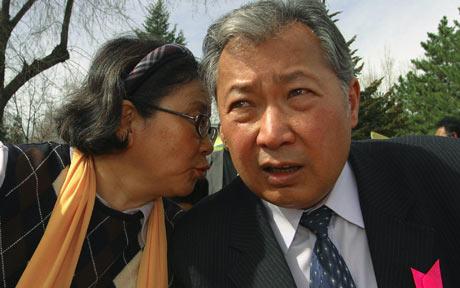
Kyrgyzstan Celebrates Two Revolutions
Publication: Eurasia Daily Monitor Volume: 8 Issue: 59
By:

Six years after ousting an unpopular leader and one year since yet another forceful regime change, Kyrgyzstan faces the dilemma of identifying the role of both events in the country’s recent history. The March 24, 2005, regime change, ousting President Askar Akayev and electing Kurmanbek Bakiyev as his successor, raises particular confusion. The meaning of regime change on April 7, 2010, is less ambiguous.
Former President Kurmanbek Bakiyev squandered his popularity within a few months of the March 24, 2005, regime change. The Tulip Revolution’s significance in Kyrgyzstan was disputed within one year. Nevertheless, the former Kyrgyz leader celebrated the date by organizing a type of military parade in central Bishkek. Five years into his leadership, however, Bakiyev was ousted after approximately 10,000 protesters gathered in central Bishkek.
Bakiyev made March 24 an official holiday in Kyrgyzstan. Despite the fact that Bakiyev fell from power, the day remains a national holiday. Skeptics in Kyrgyzstan question whether this date should still be treated as the “calendar’s red date.”
This year, President Roza Otunbayeva tried to clarify the meaning of both dates shortly before March 24. According to the president, without the Tulip Revolution, Kyrgyzstan would not be ready for its current democratic change. Neither Akayev nor Bakiyev understood the importance of a legitimate transfer of state power, the president added (www.akipress.kg, March 23). Otunbayeva has pledged that she will leave her post at the next presidential election, thus forming the first peaceful transfer of power in Central Asia.
Otunbayeva said the hopes aroused by the March 24 revolution were obviously unfulfilled, since the masses gathered again five years later. By contrast, most promises by the provisional government, including the constitutional referendum, free and fair parliamentary elections, and a legitimate government, were accomplished (www.akipress.kg, March 23).
While Bakiyev stands trial in absentia on multiple charges, a new monument will be erected in central Bishkek commemorating those who died on April 7, 2010. Eighty-six protestors died from gunshots during demonstrations in front of Bishkek’s White House. The monument will consist of two stones – black and white, symbolizing Bakiyev’s regime and the idea of a brighter future, respectively. The monument will be seven meters tall (www.akipress.kg, March 23). Prime Minister, Almazbek Atambayev, has even pledged to consider honoring those who died during the violence on April 7 with the status of “national heroes.”
Indeed, both the “Tulip Revolution” and the “April 7 Revolution” differ in a number of ways. The most obvious distinction is in the number of causalities on April 7, 2010. The new political leadership is still investigating who gave the orders to shoot and who fired on civilians (www.24.kg, March 23).
Ethnic conflict in southern Kyrgyzstan in June 2010 was the greatest tragedy of the April 7 regime change, the president admitted. Indeed, for ethnic Uzbeks in Osh city, who suffered in the conflict, and other ethnic minorities, the meaning of April 7 carries a much more negative meaning than for residents of northern Kyrgyzstan. The decentralization of political power among the parliament, prime minister, and president since April 2010 is another important difference. By contrast, one year after the Tulip Revolution Bakiyev had already formed a close clique of allies to further centralize and consolidate his own power.
With two forceful regime changes in recent memory, the question arises as to whether Kyrgyzstan is destined to repeat such political calamities. Are the country’s political elites ready to play by the rules of their political parties and avoid tweaking the constitution to serve their interests? Are state institutions strong enough to provide checks and balances and ensure the rule of law? Kyrgyzstan’s current government and parliament are closer to representing the voters’ will than elsewhere in Central Asia. However, the achievements made over the past year might easily be undone after the next presidential elections.
An unofficial competition over presidential power has already commenced in Kyrgyzstan. The threat of the coalition’s collapse is real. Representatives of the Ata-Meken, Ar-Namys, and Respublika parties told Jamestown that its end is near. The Ata-Meken party has been the most vocal in predicting the coalition’s collapse. The Ata-Jurt party has also revealed signs of defection. The party’s leaders admitted that the coalition is barely holding together. Furthermore, only a few ministries may boast about their work as competent state institutions, while the police and courts remain weak.
Rapid regime change in Northern Africa, as well as the color revolutions in Georgia and Ukraine, demonstrates that overthrowing an unpopular leader is the easier part. The post-revolutionary period represents a much more severe challenge for such countries. Much of the doubt about the significance of Kyrgyzstan’s two revolutions stems from the uncertainty surrounding the country’s future. As the country continues experimenting with its new political realities, the perceived historical importance of both March 24 and April 7 will continue to change in the years ahead.




